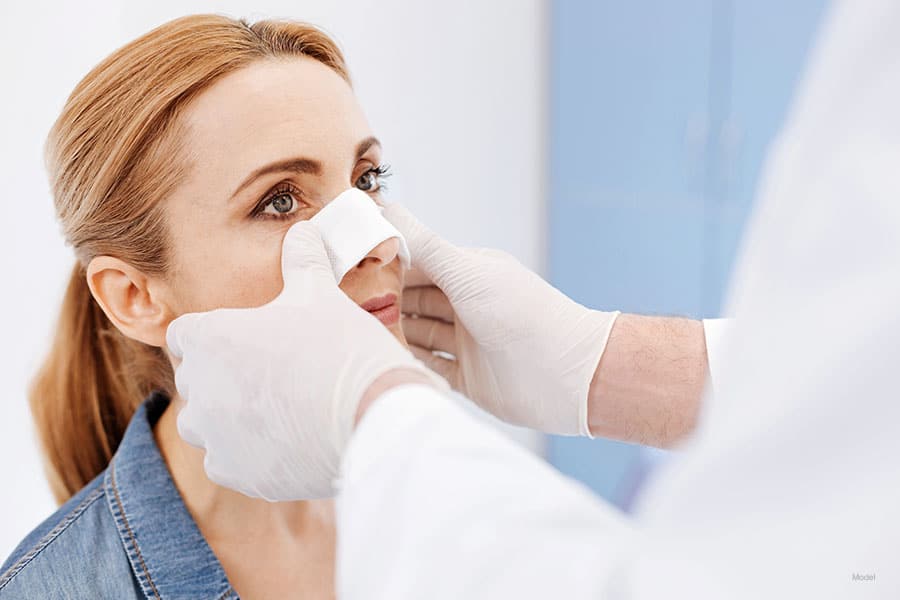
When you’re unhappy with your nose, it affects how you feel about your entire face. Embarrassment about the shape and size of your nose can cause you to feel self-conscious and struggle with your self-esteem.
At Clinica Gomez Bravo, we understand the importance of feeling confident in your appearance, which is why we offer rhinoplasty surgery.
If you’re considering undergoing rhinoplasty surgery, you may wonder what to expect from your recovery. Below, we explore some of Dr. Bravo’s tips for a successful and complete recovery.
What Happens During My Rhinoplasty Recovery?
Dr. Bravo performs cosmetic rhinoplasty to enhance the aesthetic of your nose, whether due to genetics or injury. He also performs rhinoseptoplasty, addressing aesthetic and functional concerns (such as a deviated septum).
Once your surgery is complete, initial recovery typically takes around two weeks. You can expect swelling, bruising, tenderness, or mild pain in your face immediately after surgery. Dr. Bravo will provide you with options for postoperative pain management.
Unlike many surgeons, Dr. Bravo does not use nasal packing after surgery. Instead, he either places two small intranasal drains and splints in your nose or avoids their use altogether. This method allows you to breathe easier without the nasal blockage that packing produces.
Externally, he will place a brown-colored paper tape over your nose and a thermoplastic splint when necessary.
Dr. Bravo removes the intranasal drains and splints two days after surgery if placed and the external splint and tape after seven to 10 days.
Dos and Don’ts of Rhinoplasty Recovery
DO: Keep your head elevated.
Sleeping in an elevated position after rhinoplasty surgery is essential to healing. Sleeping on your side may cause additional swelling or bruising or even displace your newly repaired nose. Additionally, keeping your head elevated reduces the chance of congestion, as you can’t blow your nose for a while after surgery.
DO: Use ice packs to reduce swelling.
An ice pack or cold compress can help reduce swelling but remember not to apply ice or cloth directly to your eyelids or face. Instead, gently place ice-cold compresses over your eyes and face in the immediate postoperative period.
DO: Keep your splint dry.
While you can shower after your rhinoplasty, it’s vital to keep your tape and splint dry. If the splint gets wet, it can loosen and fall off before your nose is healed. Gently spot-cleaning your face is acceptable if you keep all moisture away from the splint.
DO: Take short, slow walks.
While strenuous activity is discouraged for at least three to four weeks after surgery, Dr. Bravo recommends that his rhinoplasty patients take a few slow, short walks daily. Gentle movement keeps your blood circulating and encourages recovery.
DO: Gently massage your nose.
While uncontrolled localized pressure from the use of glasses should be avoided initially, a gentle but firm massage on the sides of your nose and on the dorsum and supratip area will greatly speed-up recovery. Dr. Bravo will teach you the massaging exercises you must perform once your external tape and splint are removed.
DON’T: Resume exercise or strenuous activities too soon.
While slow and moderate movement helps as you heal from rhinoplasty, strenuous exercise can set you back. Dr. Bravo will let you know when you can return to more vigorous exercise, but until then, avoid lifting heavy objects, bending over, or jostling the delicate structures of your nose.
DON’T: Wear glasses.
As mentioned above, applying ice or cold compresses to your face is fine, but avoid putting excessive localized pressure on your newly revised nose. This includes wearing glasses and sunglasses. While your glasses may seem light, even a small amount of localized uncontrolled pressure can cause skin adherences, increasing your recovery time.
DON’T: Blow your nose.
After your rhinoplasty surgery, you’ll experience some congestion due to postoperative swelling inside your nose. Do NOT blow your nose. Instead, use a saline nasal spray to gently moisturize your nostrils. In most cases, you can blow your nose after about six weeks.
You’ll inevitably have to sneeze during your recovery. When this happens, try to sneeze through your mouth to avoid damaging the delicate nasal passages.
DON’T: Take anti-inflammatory medications.
While you may want to help the swelling decrease faster after your rhinoplasty surgery, do not take non-steroidal anti-inflammatory drugs (NSAIDs). Any medications containing ibuprofen or naproxen should be avoided, as they are blood thinners and may put you at risk for nosebleeds.
Want to Learn More About Rhinoplasty in Madrid?
If you’re looking for a highly trained and experienced surgeon in Madrid, look no further than Dr. Bravo. His commitment to the satisfaction of his patients and continued innovation in surgical techniques makes him an excellent choice for your rhinoplasty procedure.
For more information or to schedule a consultation, call +34 91 575 60 60 or fill out the contact form on the website.


